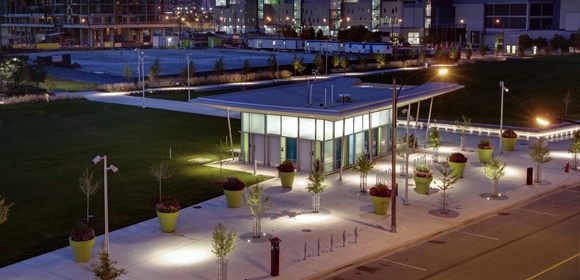 Fencing, gates, lighting and landscaping are easy to overlook in designing a robust security plan including electronic systems such as video surveillance and access control. Yet CPTED – crime prevention through environmental design – can make a good plan even better.
Fencing, gates, lighting and landscaping are easy to overlook in designing a robust security plan including electronic systems such as video surveillance and access control. Yet CPTED – crime prevention through environmental design – can make a good plan even better.
CPTED should start at the beginning of any new or updated plan – the risk assessment, and that begins on the facility perimeter. Fencing around the property, including iron or barbed wire, can help prevent unauthorized entry. Ideally, fencing should be set in 3-foot trenches and then filled with concrete to discourage digging. Fiber optic cable, with periodic sensors running along the fence, can detect movement and alert security to a possible breach. Stainless steel anchored or floating fences are valuable for helping prevent divers from accessing facilities set along riverbanks, bays or lakes. Sensors on the fencing also can integrate with software controlling surveillance camera to help security formulate an alarm response.
Both fencing and gates can be made of the same type of steel cable used to stop fighter jets as they are landing on aircraft carriers. This cable is given a K-rating, a measure of the kinetic energy – speed plus weight – it can resist. These specialized gates can easily stop a 15,000-pound truck traveling at a speed of 50 miles per hour, and the cable is extremely difficult to cut.
Gates are required for employees and visitors to enter the project. Employees should use a mounted card reader or keypad to open a rolling gate. The same gate may be remotely opened by security once a visitor’s identity has been authenticated using a video intercom.
Any trees or large bushes along the perimeter should be removed so they cannot be used to climb over fences. Landscaping planted farther into the property should be trimmed to not block views of doors and windows from the street. However, low, thorny bushes directly beneath ground-floor windows can deter criminals.
It may not be possible to make changes to roads around a property, but driveways leading into the project can be altered. That may reduce potential top speeds of explosive laden vehicles, currently one of world terrorism’s easiest-to-obtain weapons. Bollards – sturdy concrete blocks or barriers – are useful for protecting entries from taking a direct hit from a vehicle. These barriers can be designed to serve as planters, trash receptacles, or benches to blend in with the landscape plan.
Lighting helps deter crime at night, or throughout the day in a parking garage. Be careful not to go too bright as excessive lumens may cause inverse blindness for pedestrians and drivers. The best approach is a uniform level of power across the property. Ensure that your facility has an alternative power source to maintain lighting and gate operation during a power outage.
Lost or confused drivers and pedestrians are easier targets for criminals so adequate signage helps people locate parking, building entrances, elevators and emergency call stations. Make sure signs have easy-to-read fonts and consistent messages and are placed often throughout the project. Colors, characters or other designs help visitors identify parking levels and other facilities in a multi-building site. Also, limit access and entry into outbuildings storing tools, ladders and other devices that could be used to get inside a building.
A well-maintained facility sends a message that management is serious about the experience and safety of employees and visitors. That requires immediately removing graffiti, replacing burned out lights, making repairs to windows and building exteriors and keeping landscaping well groomed. Criminals see a clean, well-maintained facility as a sign that security is also a high priority. Also, dressing all facility personnel in uniforms will help people quickly identify them as a person to turn to in an emergency.
Electronic security tools have become an absolute must for virtually any project ranging from a K-12 campus to a hospital or a multi-tenant office building. But don’t forget CPTED. Through the addition of well-planned soft and hard landscaping, security is tremendously enhanced.
